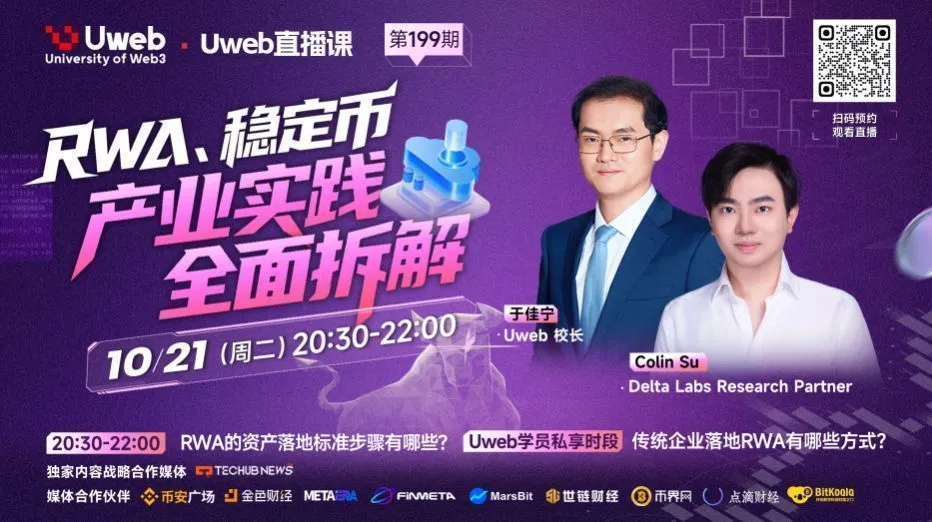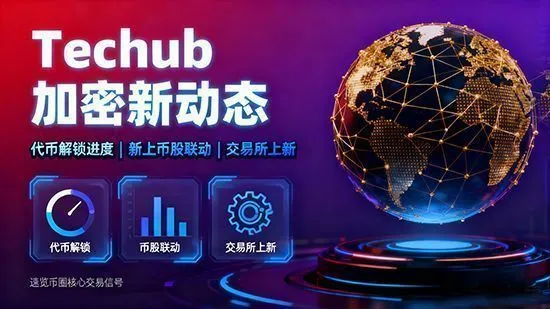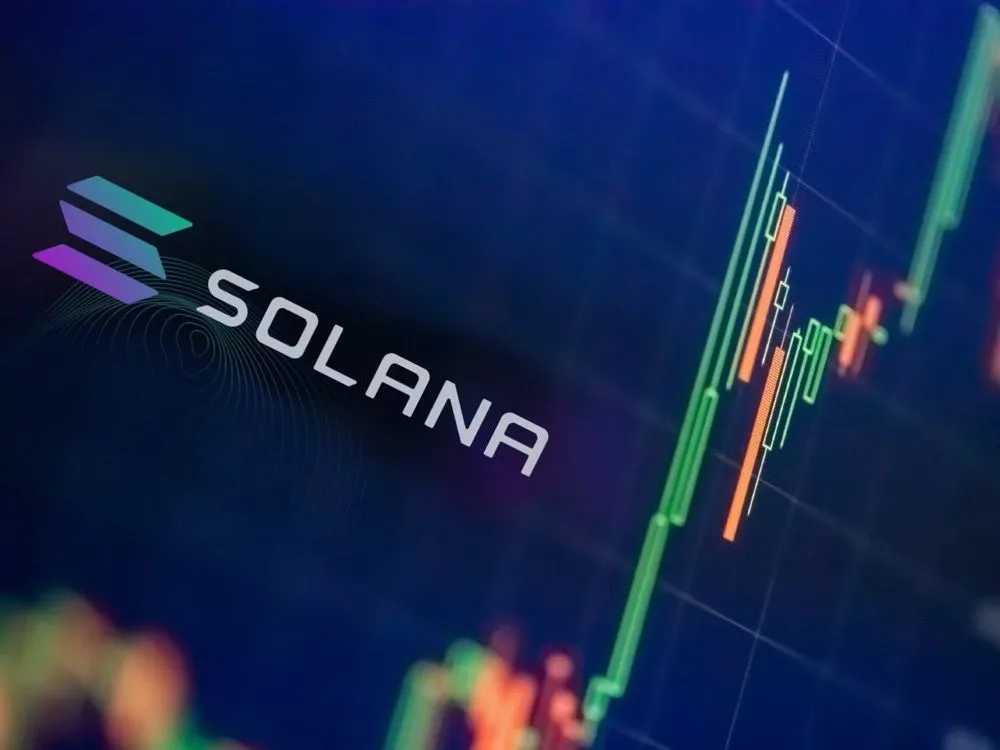Big Time is building a complex and balanced sustainable virtual economy, setting a standard model in the digital gaming world.
Written by: Fiona, IOSG Ventures
This article is an original work by IOSG and is for industry learning and exchange only. If you need to quote, please indicate the source. For reprints, please contact the IOSG team for authorization and reprinting instructions. Special thanks to the former Bigtime Chinese lead, Dacheng, Bigtime community ambassador, Dahongniu, Jocy, and the support and advice from the IOSG team!
All numbers in this article are predictions, and IOSG is an angel investor in Bigtime. Fiona is a Bigtime player, and all have a vested interest. The views in this article are not intended as recommendations or investment advice. Investment carries risks, so readers should do their own research.
It has been 2 months since the official launch of the gold-making version (pre-season) of Bigtime. There are already many analysis articles on the market, but the perspectives are different. Gold-making players focus on "low production," "finding hourglass merchants," and "charging price changes," while coin speculators pay attention to "net deflation" and "consumption." As participants in the gaming and Bigtime early investment fields, we have some understanding of gold-making and want to objectively introduce the economic characteristics of this innovative GameFi product from different perspectives.
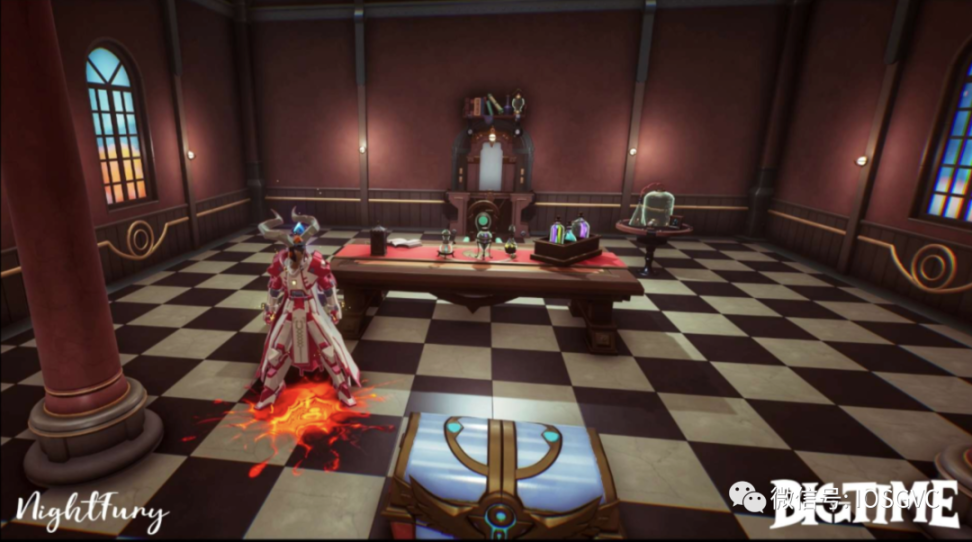
Ecosystem of the game is gradually improving
W Labs did a good job of summarizing the economic model pattern (single/multi-currency, as well as gold + currency standard) in the previous chain game cycle, which will not be elaborated here. Strictly speaking, Bigtime is a single-currency model, and tokens will be used as the core output to incentivize players. This model is not uncommon in the previous chain games, and most of them ended up with consumption not keeping up with output, and the curve of related tokens can be referred to as a normal distribution curve. However, Bigtime has made some unique improvements in this regard, leaving aside the game itself and focusing only on the economy.
The basic economic framework of Bigtime is: players of different roles (dungeon runners, hourglass merchants, equipment manufacturers, and other small to medium-sized merchants) complete corresponding economic and game activities, with crystals (gold standard) as the main consumption. Through the participation of hourglass merchants and other economic intermediaries, the economy cycle is completed with the output of tokens. Parameters need to be adjusted here to make the roles interdependent and balanced.
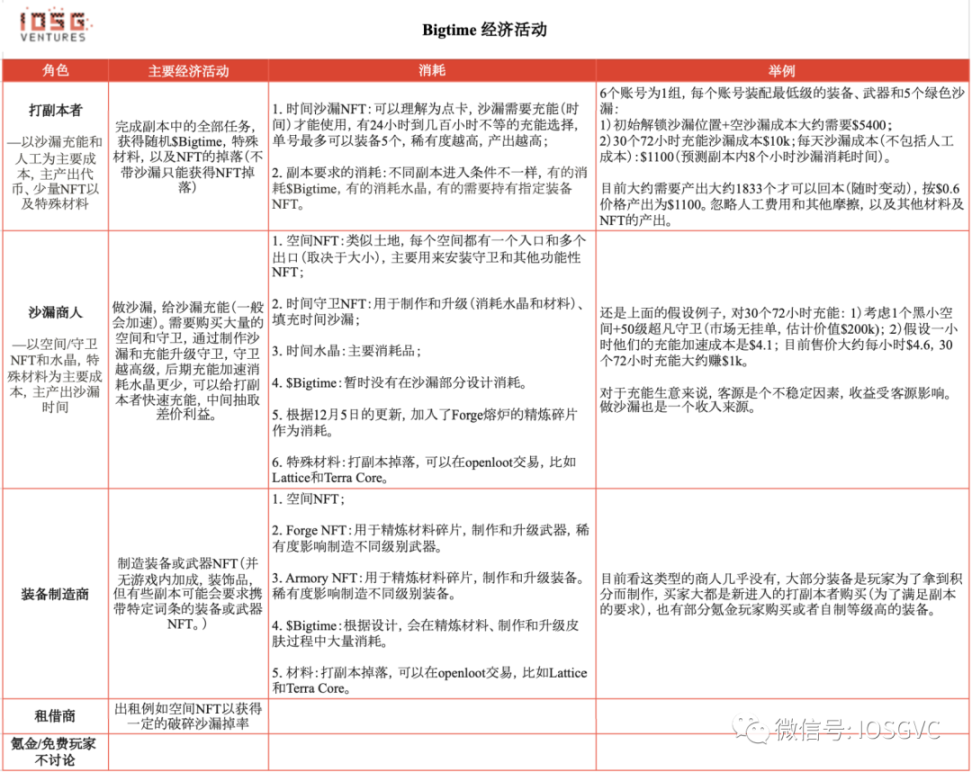
Note: All numbers in the examples are estimates and assumptions, and the numbers will change at any time, for reference only.
Source: IOSG Ventures,
https://docs.google.com/spreadsheets/d/1H1R9EJTRtZs_dUXERRQCzn1WsCJi7SqOgX8JCpA3iGA/edit#gid=0
Role: Dungeon Runners (main cost is hourglass charging and labor, main output is tokens, a small amount of NFT, and special materials)
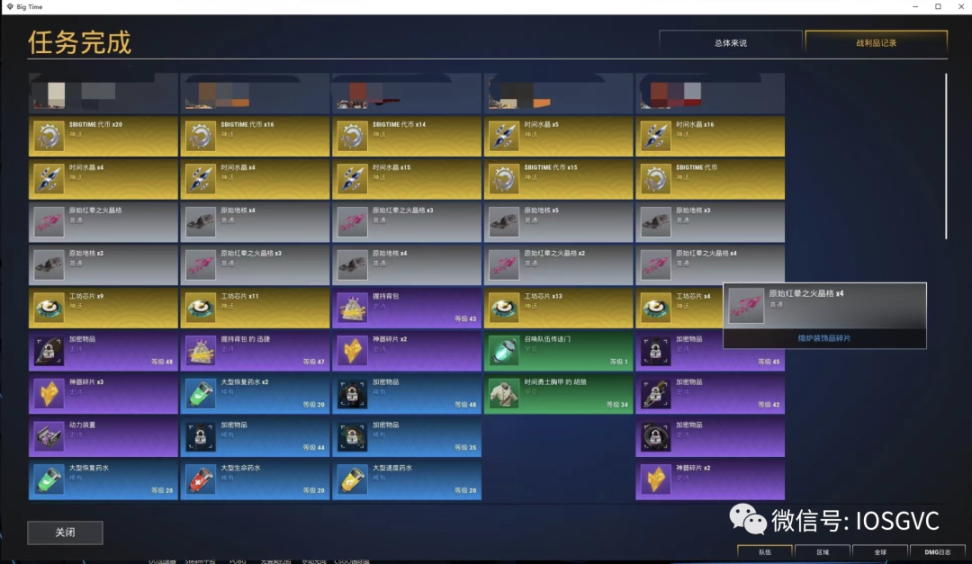
Main economic activities: Complete all tasks in the dungeon, obtain random $Bigtime, special materials, and NFT drops (without an hourglass, only NFT drops can be obtained)
Consumption:
- Time hourglass NFT: can be understood as a game card, the hourglass needs to be charged (time) to use, with charging options ranging from 24 hours to several hundred hours, with a maximum of 5 per account. The higher the rarity, the higher the output.
- Consumption required for dungeons: different dungeons have different entry conditions, some consume $Bigtime, some consume crystals, and some require specific equipment NFTs.
Example:
A group of 6 accounts, each equipped with the lowest level of equipment, weapons, and 5 green hourglasses: 1) The initial unlocking of the hourglass position + the cost of an empty hourglass is approximately $5400; 2) The cost of 30 72-hour charging hourglasses is $10k; the daily hourglass cost (excluding labor cost) is $1100 (predicted 8 hours of hourglass consumption time in the dungeon). Currently, it takes about 1833 outputs to break even (subject to change at any time), with an output price of $0.6 for $1100. Ignoring labor costs, other frictions, and the output of other materials and NFTs.
Role: Hourglass Merchants (main cost is space/guard NFT and crystals, special materials, main output is hourglass time)
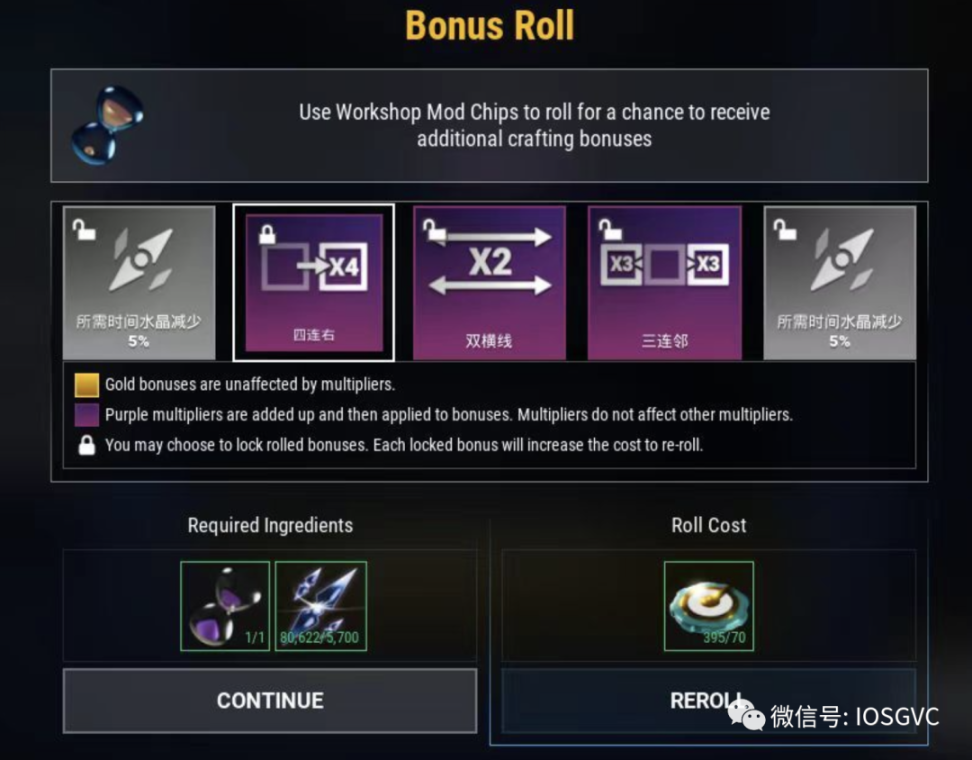
Main economic activities: Making hourglasses, charging hourglasses (usually accelerated). Need to buy a large number of spaces and guards, make hourglasses, upgrade guards through production, the higher the level of the guard, the less crystals are consumed for later charging acceleration, and can quickly charge for dungeon runners, extracting price difference benefits in the middle.
Consumption:
- Space NFT: similar to land, each space has an entrance and multiple exits (depending on size), mainly used to install guards and other functional NFTs;
- Time guard NFT: used for production and upgrade (consumes crystals and materials), filling time hourglasses;
- Time crystals: main consumable;
- $Bigtime: currently not designed for consumption in the hourglass section.
- According to the update on December 5th, refined fragments from the Forge furnace have been added as consumption.
Example:
Using the previous hypothetical example, for 30 72-hour charging: 1) Considering 1 black small space + level 50 extraordinary guard (no orders on the market, estimated value of $200k); 2) Assuming their hourly charging acceleration cost is $4.1; currently, the selling price is about $4.6 per hour, making approximately $1k for 30 72-hour charging. For the charging business, customer sources are an unstable factor, and income is affected by customer sources. Making hourglasses is also a source of income.
Role: Equipment Manufacturers

Main economic activities: Manufacturing equipment or weapon NFTs (no in-game bonuses, but some dungeons may require specific attribute equipment or weapon NFTs).
Consumption:
- Space NFT;
- Forge NFT: used for refining material fragments, making and upgrading weapons, rarity affects the production of different level weapons.
- Armory NFT: used for refining material fragments, making and upgrading equipment. Rarity affects the production of different level equipment.
- $Bigtime: according to the design, it will be heavily consumed in the refining of materials, making, and upgrading skins.
- Materials: dungeon drops, can be traded on openloot, such as Lattice and Terra Core.
Example:
Currently, there are almost no merchants of this type. Most of the equipment is made by players to earn points, and buyers are mostly new dungeon runners (to meet the requirements of the dungeon). There are also some whales who buy or self-craft high-level equipment.
Evolution of the Player Value Chain
Over time, the economic importance of different roles has gradually become apparent, and Bigtime attempts to guide different players to compete with each other at different stages of the journey.
Phase One: Dominance of Dungeon Runners in the Economy
October 7th (start of Broken Hourglass drop, marking the official gold-making) to the first economic adjustment on October 18th
During this time, players were dominated by dungeon runners, and hourglass merchants had not yet appeared because the cost of hourglass charging was particularly low at the time, roughly estimated to be 1/20 of the current hourglass charging cost. On October 18th, the first major economic change by the official increased the cost of hourglass charging, making it impossible for dungeon runners to simultaneously manage the cost of charging and gold-making. At the same time, the cost of making hourglasses was also increased because the official found that most time guards were busy making hourglasses, leading to a surge in hourglass supply, exceeding their expectations.
Through these changes, the official differentiated the roles, evenly distributing the tasks of time guards (such as production, charging, and disassembly). The high cost of charging and the scarcity of time guards led to the emergence of hourglass merchants, taking the economy into the next phase.
Phase Two: Interdependence and Balance between Dungeon Runners and Hourglass Merchants
Update from October 18th to December 7th
Hourglass merchants engage in the business of selling water, providing dungeon runners with the main gold-making consumable—hourglass time, which greatly affects the economic benefits of the latter. Before December 7th, the consumption of hourglass merchants was not closely related to dungeon runners. However, according to the latest economic update on December 7th, their balancing relationship became increasingly apparent. This update added decorative refining materials as consumables, with most raw materials coming from dungeon drops and requiring refining in the furnace and armory. As a result, the cost of hourglass merchants will also be related to the earnings of dungeon runners. More importantly, this update encouraged the presence of equipment manufacturers, who will become an important part of the economy by producing decorative items using the furnace and armory.
Phase Three: Completion of the Economic Cycle by Dungeon Runners, Hourglass Merchants, and Equipment Manufacturers
Future Prospects
In this phase, in addition to necessary economic control and adjustments, the entry of whales is also needed. This prerequisite requires a larger player base, and the community ambassador Dahongniu estimates that the player base needs to reach at least 100,000 before the skin economy can be activated. The official has not yet announced the number of active players, but it is roughly estimated from the leaderboard, the number of independent addresses producing output, etc., that the daily active users are around 5k-10k. This number is still far from the peak chain games of the previous bull market (Stepn had 300k, Axie had 2M), indicating a lot of room for growth. The road is tough, but there are still some signs of progress. It has been observed that the top 4 decorative items in terms of liquidity and rarity (without attribute bonuses and minimal dungeon consumption) have increased in price compared to the start of the pre-season, indicating the presence of a few whales.
Fair distribution is crucial under strong economic control
As the game economy is still in its early stages, the team's control over the economy is characterized by high frequency and large changes. Although it may cause some harm to players in the short term, it will lead to a healthier and more stable economy in the long run. The official's control over the game economy is reflected in several aspects:
- The economic model has been adjusted several times at various stages, such as several adjustments to the cost of hourglass charging, and the addition of many additional special material consumptions compared to the earliest additions. These materials require participation in in-game economic activities to drop, with the aim of continuously balancing the interests of hourglass merchants and dungeon runners.
- Control over the output of $Bigtime. Tokens can only be obtained from game dungeons or by dismantling broken hourglass drops (broken hourglass drops are quite random and in small quantities, so they are temporarily ignored), as well as airdrops. In addition to being influenced by the number of gold-making players, the token output is also strictly controlled by the project team, so the return on investment for gold-makers is not stable.
- Monitoring the balance within the game. Some time ago, there was a surge in the price of guard NFTs (used to make hourglasses), with the lowest-level common white guard price rising from $50 to a high of $729. The community speculated that a large player wanted to monopolize the business of hourglass merchants, continuously buying guards on the market to gain pricing power for hourglass charging. After the official noticed this, they gradually controlled the price by increasing the circulation of guards through measures such as postcard airdrops and increasing the probability of guards being obtained from blind boxes.
Iteration and updates will be the long-term theme of Bigtime
Bigtime has introduced many complex elements into its economic system: time crystals, hourglass charging, tokens, decorative fragments, and more. Over time, under the premise of fair distribution, this dense, complex, and intertwined economic system needs to be controlled to achieve rebalancing. For example, the price threshold of time guards and hourglass NFTs will control the number of new players entering the game; reducing the rate of asset distribution will have a positive impact on token prices, and so on.
The revenue of the Bigtime project is not tied to tokens, and they do not want to interfere too much with the price of the token. Although they do not have the same economic interests as players (no token exposure), the combination of crystals (the main consumable), NFT sales, and market fees will generate very good company-level income, with more stable long-term incentives, without the need to sell tokens to make a living, and unaffected by the bull and bear markets of the secondary market (similar to traditional game developers). Since the start of the pre-season, the project has sold blind boxes four times, generating nearly 7.85 million in revenue. Since most items have not yet been put on the chain, we can only roughly estimate: 1) Assuming that every 50 crystals produce 1 token, the revenue from crystals is approximately 5 million; 2) Based on a market total trading volume of 45 million (from the start of the pre-season until now), calculated at 5% transaction fees, ignoring the 3.5% token withdrawal fees, this amounts to around 2 million. We can roughly estimate that the total revenue for the pre-season over these two months can reach nearly 15 million, with the stable and continuous market fees and crystal revenue estimated at 7 million. At this stable revenue level, the annual income is about 42 million, and considering the bull market premium, the estimated annual income is only 50%, so the expected annual income for the next two years is about 20 million.
In the long run, having whales as consumers within the economic chain is a major challenge. It is not easy for Web2 users to enter, and the decorative skin economy is not yet operational. The value of the furnace and armory is very low, while the prices of essential guards and hourglasses for gold-making remain high, leading to a relatively distorted asset market. The consumption of tokens within the game is also insufficient. This requires another order of magnitude increase in the player base. A good sign is that there has been some increase in the furniture market for spaces, and there are also many new players who are willing to pay for aesthetics. The next stage will be a trend of encouraging the growth of equipment manufacturers. If the attributes of decorative items and the rights of whales are increased, it will provide some short-term help, but in the long run, an increase in the player base is still needed. Ultimately, both the team and the players/token holders hope that more people will play the game and that the game will run in the long term. In this regard, the economic goals of the project team and the players are aligned.
免责声明:本文章仅代表作者个人观点,不代表本平台的立场和观点。本文章仅供信息分享,不构成对任何人的任何投资建议。用户与作者之间的任何争议,与本平台无关。如网页中刊载的文章或图片涉及侵权,请提供相关的权利证明和身份证明发送邮件到support@aicoin.com,本平台相关工作人员将会进行核查。

